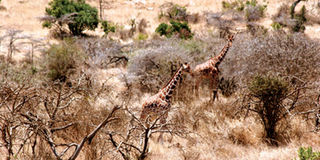Private wildlife groups plan to set up umbrella organisation

PHOTO | FILE Private wildlife areas plan to set up an umbrella body to champion their concerns.
What you need to know:
- The proposed Kenya Association for Wildlife Conservancies is targeting membership from 120 community and private ranches and local authorities with game reserves which have wildlife outside protected areas and animal protection groups
- Wildlife management in private and community conservancies, games reserves, and national parks do not operate at the same level
- The concept for the association was first mooted at a workshop in Nairobi bringing together participants from all over the country
Community and private wildlife conservancies are setting up an umbrella association as part of efforts to raise the standards of the Kenyan tourism industry.
The proposed Kenya Association for Wildlife Conservancies is targeting membership from 120 community and private ranches and local authorities with game reserves which have wildlife outside protected areas and animal protection groups.
Unlike stakeholders in other sectors of the economy, those in wildlife conservation do not have a common body for coordination and voicing their concerns.
“Land owners with wildlife have not been well represented. They have not been benefiting as much as they should from their wildlife. The association is one way of ensuring that they benefit more from this resource,” said Mr Allan Earnshaw, a conservationist from Nakuru and an interim board member of the proposed group.
According to Mr Earnshaw, the association will offer a platform for stakeholders to agitate for favourable policies and give members a legal basis for deriving benefits from wildlife.
Wildlife management in private and community conservancies, games reserves, and national parks do not operate at the same level.
KWS says communities lack the capacity to manage animals and that their standards are much lower than those in its national parks.
“When tourists come, the standards that they see in the national parks are not the ones found in game reserves, community and private conservancies. We are not just looking for more tourists but better-paying tourists,” said Mr Earnshaw.
The concept for the association was first mooted at a workshop in Nairobi bringing together participants from all over the country.
The first of a series of regional meetings was held at Sportsman Arms Hotel in Nanyuki with participants from Laikipia and Samburu.
Similar workshops will be held in Voi, Nairobi, Nakuru, and Eldoret before registering the association.
“What we are looking for is a win-win situation where a woman in a village could put food on the table out of the money derived from wildlife protection,” said Ms Munira Bashira, Kenya Wildlife Service assistant director in charge of community enterprise development.
With wildlife being a key product for the tourism industry, stakeholders say bringing conservancy owners under an umbrella organisation would help in managing the sector better.
The KWS, for instance, hopes to establish a database of all non-state actors in wildlife conservation. “We’ll be able to know the acreage of various conservancies and their carrying capacity to help us organise the industry,” said Ms Bashir.
Land owners with wildlife feel that due to absence of a national entity, they lack the bargaining power to advance their concerns.
Despite having wildlife resources, an educated human capital, a relatively advanced system of land tenure, a progressive Constitution, significant economic potential, as well as massive donor support, experts say the local wildlife sector has not been thriving.
According to Ms Bashir, various studies on the sector point to, among others, a weak governance framework and inadequate institutional arrangements for effective management and coordination, especially in non-protected areas.




